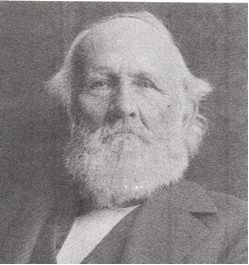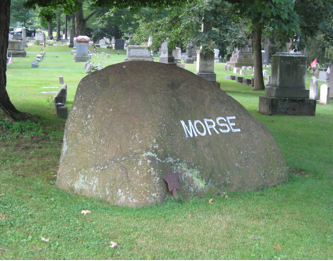Editor’s Comments: Visitors to the Riverside Cemetery
should stop for a moment to view this monument placed in
memory of the Henry Kirtland Morse Family. It is located
a few yards west of the Civil War Soldier’s Monument and
in the center of the Old Section. It was placed there by Henry
before his death just a hundred years ago this past June. For
a more complete biography of the Morse Family look in the
Journal under “Names” .

Henry K. Morse
(1822-1909)
Henry grew up on the northern edge of the Village of Poland and spent most of his 87 years enjoying the benefits of his hard work. He was born into a prominent family with a long list of accomplishments and he added more to that list. Mr. Morse lived during a period when great historical events happened. He saw the canals and railroads enter the Mahoning Valley and he witnessed the Mexican War, the Civil War and the Spanish-American War. He experienced the introduction into the world of science the telegraph, the electric light bulb, the telephone, the airplane, and indoor plumbing.
As a teenager he listened to his material grandfather, Turhand Kirtland, tell of how the Western Reserve was surveyed and the founding of both Poland Township and Poland Village. His uncles were farmers and large land owners who played an active role in the planning and development of the Village of Poland. Henry’s own father, Elkanah Morse, had accumulated a large fortune in the shipping business on Lake Erie only to lose it all when one of his vessels was shipwrecked. When Elkanah Morse was stricken with cholera while returning from California in 1850, Henry inherited the homestead fronting on Water Street and including land from Second Street to the what is now the Village northern boundary line. The homestead also extended across Yellow Creek and included more than 6 acres Henry later sold to the Riverside Cemetery.
Henry’s first marriage was to Mary Lynn Wick (1818-1879). Four children were born of this marriage and were Henry Grant Morse (1850-1903), Charles James Morse (1852-1911), Edwin Kirtland Morse (1856-1942), and Mary W. L. Morse (1859-1952). Many old residents of Poland remember Mary, the daughter, and the fine house she lived in on Water Street. Henry Grant Morse moved to Camden, New Jersey and became the founder and president of the New York Shipbuilding Co. while Charles moved to Evansville, Illinois, to become a capitalist and traveled extensively collecting Japanese art objects. Edwin Morse became a consulting engineer for Jones and Laughlin in Pittsburgh and built subways. They all requested to be buried with their parents in the Riverside Cemetery and next to the Morse Rock.
The Morse Rock was originally located in the middle of Yellow Creek downstream from the Cemetery Bridge. Young swimmers used the rock as a diving platform. After the swimming pool was drained Henry Morse had the rock placed in his cemetery plot so that the ground represented the original water level of the swimming pool. Much of the rock is below the ground level. The Morse Rock is estimated to weigh 12 tons and was somehow moved to its present location by pulleys, chains, and good old Yankee ingenuity.

Morse Family Monument
